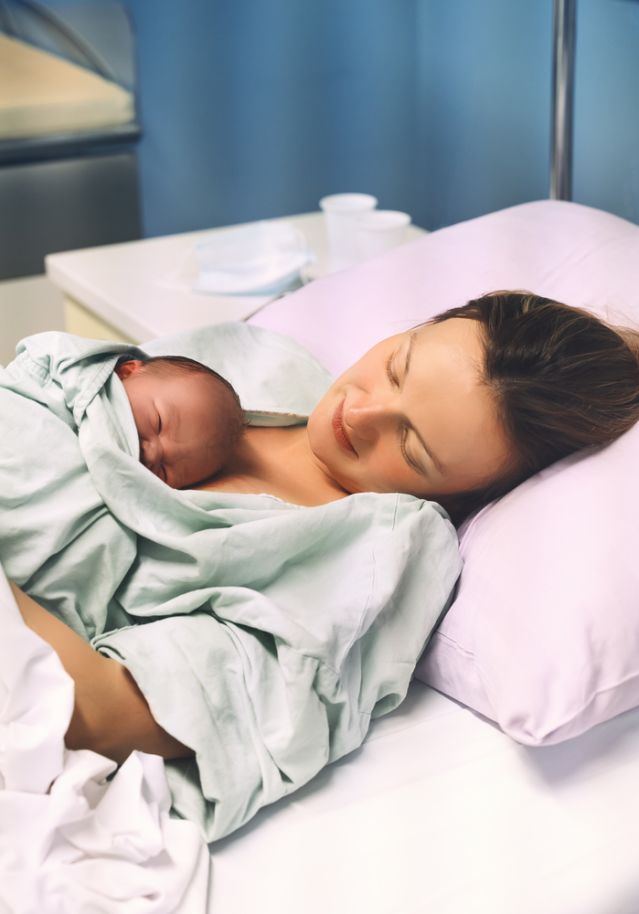Hormones
Born to Bond: Vaginal Birth Boosts Physical, Mental Health
And why C-sections can disadvantage mothers and infants.
Posted April 5, 2023 Reviewed by Tyler Woods
Key points
- Vaginal birth biologically primes parenting behavior and bonding, and physically alters the newborn to ready it for life outside the womb.
- These changes trigger a virtuous cycle of behavior and response that supports the parent-child relationship and healthy infant development.
- Unfortunately, these processes are disrupted by C-section birth, which can save lives, but sometimes has negative long-term repercussions.

Part one of a two-part post
In the shadow of America’s shameful maternal death rate lies another pervasive health crisis: nearly one-third of U.S. births are by Cesarean section. This means that over a million new Americans start life facing risks to their development every year, often unbeknownst to their parents.
Vaginal birth is not just a means of moving an infant from the uterus to the outside world. Rather, it is a complex interaction between the fetus and the mother’s body that profoundly alters the neurobiology and physiology of each, preparing them for the new stage of life ahead. Vaginal birth impacts everything from the mother’s instinctive reaction to her baby’s cries to the newborn’s organ maturation.
Parenting a newborn is incredibly difficult and demanding, so nature has given mothers a helping hand, beginning with hormonal changes during pregnancy that rewire the brain in preparation for parenthood. Then, vaginal birth builds on that foundation by releasing a flood of hormones which transform new mothers’ brains, altering their cognitive, salience, and reward systems. This makes bonding and new parental behaviors easier and exceptionally rewarding, and radically alters their sense of themselves and their well-being. A virtually unbreakable lifelong bond is rapidly formed between mother and infant, so strong that while romantic love frequently ends in a breakup, women seldom “divorce” their children.
The Impact of Vaginal Birth on Newborns
For the newborn, the impact of vaginal birth is at least as profound. Birth does not naturally take place when a fetus is ready to breathe air, nurse, and digest milk, but instead when it is ready for the vaginal birth process itself to add the finishing touches that prepare it for those new tasks.
In infants, the physical stress of the journey through the birth canal alters the immune cells in blood plasma and releases hormones which promote the maturation of the lungs and intestines. It also deactivates fetal genes and triggers postnatal epigenetic changes, including those that support antibody production, stress responses and glucose regulation. Vaginal birth washes the newborn in the microbiome of the mother’s birth canal, seeding its body with beneficial microorganisms which will aid its digestion, immune response, and much more.
Additionally, the vaginal birth process initiates new, unlearned behaviors in newborns, including breathing air, suckling for nutrition, seeking physical closeness and warmth, and crying when distant from their mothers.
The Impact of C-Section Births
After C-section birth, infants may display these same behaviors, but often less vigorously, because C-sections eliminate or reduce (depending upon timing) these vital processes and the profound neuro-physiological reorganization they trigger. This increases such newborns’ risk for conditions ranging from post-birth hypothermia to lifelong disorders including asthma, obesity, diabetes, celiac disease, juvenile arthritis, autism, cognitive difficulties, and mental illness.
Mother-child bonding can also become more difficult, increasing the mother’s risk for postpartum depression and potentially impacting the child’s long-term development.
Fortunately, many children born by C-section go on to have normal lives, and primary caretakers who don’t experience vaginal birth can develop alternate pathways for developing parental bonds by means of conscientious, focused efforts. However, it isn’t automatic or easy. The unfortunate consequences of our excessive C-section rate may be hidden in plain sight, ranging from news of rising perinatal and postpartum depression and reduced infant-maternal bonds, to a teen mental health crisis.
The Link Between Vaginal Birth and Parenting
The importance of the vaginal birth process and the consequences of missing out on it have to do with our nature as mammals. Ruth Feldman, the Simms/Mann professor of social neuroscience and director of the Center for Developmental Social Neuroscience at Reichman University, with a joint appointment at Yale Child Study Center, is a leading researcher of the human capacities for love, empathy, and resilience.
“Being born a mammal implies that the brain is immature at birth and develops in the context of the mother's body and caregiving behavior,” she wrote. “Infants rely on the provisions embedded in the mother's body, such as smell, touch, heat, or movements, and the expression of caregiving behavior for maturation of neurobiological systems that sustain participation in the social world.”
From blind, mewling kittens to monkey infants clamped onto to their mothers’ backs, mammalian young require intensive parenting as soon as they are born. Human babies are especially dependent because they are born without fully developed brains or endocrine, temperature regulation, sleep, hormonal, digestive and cardio-pulmonary systems, and require near-constant physical contact with a caregiver to regulate them. Even an hour of separation from their mothers causes two-day-old infants physiological stress and interferes with their sleep. Human infants are closer in some ways to kangaroo joeys, which mature in their mothers’ pouches, than to alert, clinging baby monkeys—indeed, we would have to gestate for another nine to 12 months to catch up with other primate newborns.
Although mammals rely on mothering for species survival, no one teaches a lioness or a horse how to parent. Instead, vaginal birth itself unleashes tides of hormones and neurotransmitters that activate specific neural pathways, triggering automatic responses so powerful that even first-time mothers will display brand new behaviors upon giving birth, from licking their babies, to assuming the right position for nursing, to responding to infant cries.
These changes also transform the normal adult aversion to crying infants into an attraction to them and a desire to care for them. Vaginal birth even triggers both mothers’ and infants’ ability to recognize and bond with each other based on scent.
How does vaginal birth accomplish all this? Through the most intense and rapid brain alternations in adult life—and the intense feelings they create. Many human mothers experience the greatest high of their lives when their infants are born. They are often floating on cloud nine, and fall in love with their infants the moment the newborn is placed, skin to skin, on their chests. That euphoria, an extreme surge of oxytocin, dopamine, and other neurotransmitters caused by labor and delivery, is necessary for mammals like us to overcome the strain, pain, and exhaustion of childbearing to immediately nurse and care for our infants. Nursing produces a milder form of the same high.
In this way, vaginal birth triggers a virtuous cycle, where the mother and infant are drawn to each other and instinctively engage in mutually rewarding behaviors. This close, affectionate physical contact facilitates the infant’s neurophysiological maturation and supports normal social, cognitive, and emotional development, as well as the mother-child bond.
Implications for C-Section Parents
C-section birth suppresses both the neuro-remodeling that promotes new parenting behaviors and the hormonal surge that makes them so rewarding. Of course, parents who don’t give birth vaginally (including fathers and adoptive parents) can still provide lots of close physical contact and bond with their babies—they just don’t have the same hormonally-enhanced motivations and behavioral prompts that vaginal birth provides, so they must sometimes make deliberate efforts to compensate.
Summarizing some of his vast body of research, Larry Young, Director of the Center for Translational Social Neuroscience at the Silvio O. Conte Center for Oxytocin and Social Cognition, and the William P. Timmie Professor of Psychiatry and Behavioral Sciences at the School of Medicine at Emory University, says “…this does not mean mothers with C-section cannot bond, they can nurse to release oxytocin, and skin-to-skin contact and eye-gazing can also stimulate oxytocin release, it just might not be the flood that happens with vaginal birth, which animals need to drive their behavior.” In other words, with consistent interventions (discussed further in Part 2), it is possible for parents to overcome the deficits caused by C-section birth.
Though C-sections are sometimes essential and life-saving for both mother and child, their potential mental and physical health repercussions are often not fully understood by either parents or physicians, who may take decisions about birth method too lightly. Caesarian sections remain far more prevalent than medical necessity demands, with the result that millions of American families may struggle to overcome unrecognized deficits.
Every child deserves a start in life that enables their full flourishing and psychological health, and every mother deserves to understand how her body’s capacity to give birth was evolutionarily designed to jumpstart her parenting brain and prepare her emotionally and neurologically for successful mothering. In part 2, we will explain how the biological processes set in motion by vaginal birth lead to the positive early experiences essential for healthy child development—as well as what happens when it goes wrong, and how parents of C-section or premature babies can improve their outcomes.




